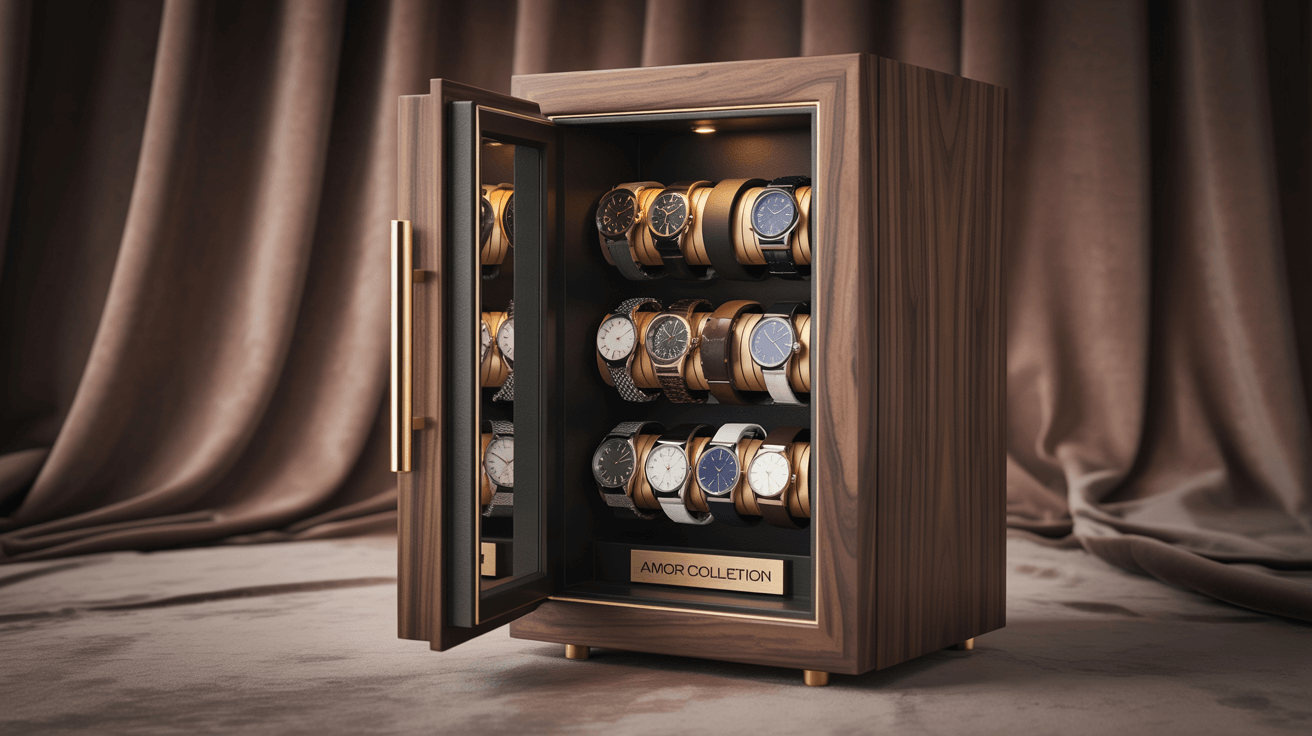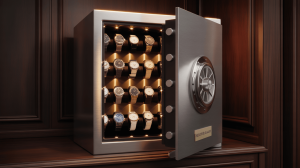How to Choose the Perfect Custom Watch Winder Safe for Your Collection. But here’s the kicker… A bespoke winder safe tailors security, winding performance, and style exactly to your needs, ensuring every piece in your collection stays safe, accurate, and beautifully displayed.
1. Define Your Collection Needs
Start by cataloging each watch’s type, case diameter, and winding requirements. Note how many automatics need winding versus static storage. Decide if you also want dedicated jewelry compartments or tool drawers. Mapping current and future acquisitions reveals the precise capacity you need. Use this clarity to avoid wasted space and ensure your custom safe fits your collection like a glove.
| Collection Size | Watch Count | Storage Recommendation |
|---|---|---|
| Small | 1–4 watches | Compact winder trays |
| Medium | 5–8 watches | Mix of winders and pillows |
| Large | 9+ watches | Modular trays + jewelry drawers |
2. Determine Security and Certification Requirements
Your custom safe should meet recognized security standards. UL RSC or ETL burglary certifications guarantee resistance against common forced-entry tools. A multi-bolt steel door with concealed hinges adds layers of defense. If fire risk is a concern, aim for UL 72 Class 350 fire ratings to keep interior temps under 350 °F for at least 30 minutes. These certifications validate your safe’s ability to protect high-value timepieces and jewelry.
3. Balance Fire and Climate Protection
Beyond burglary, extreme heat, humidity, and dust threaten movements and metal finishes. Composite fireboard linings and intumescent seals block heat and smoke. Climate-sealed doors (IP54) prevent moisture ingress. Built-in desiccant chambers or active dehumidifiers maintain relative humidity between 40–50%. This balanced protection preserves lubricants, prevents strap drying, and stops tarnish, ensuring your watches and jewelry remain pristine.
4. Choose Exterior Materials and Finishes
Select materials that blend with your décor and offer durability. Options include powder-coat steel, brushed stainless, wood veneers (walnut, oak), or leather wraps in custom colors. High-quality veneers resist warping, while UV-stable powders prevent fading. Your finish choice defines the safe’s presence in any room—whether it’s a modern office or traditional library.
| Material Option | Visual Style | Durability |
|---|---|---|
| Powder-Coat Steel | Matte contemporary | Scratch and fade resistant |
| Brushed Stainless | Modern industrial | Corrosion-resistant |
| Walnut Veneer | Warm traditional | Requires occasional polishing |
5. Select Interior Organization Features
A modular interior keeps each piece secure and accessible. Customize adjustable foam inserts, velvet-lined watch pillows, ring rolls, and necklace hooks. Include removable trays for future expansion. Hidden drawers beneath the main layout store straps, tools, and paperwork out of sight. Thoughtful organization reduces handling wear and creates a refined presentation.
6. Evaluate Locking Mechanism Options
Lock choices impact convenience and reliability. Mechanical dials never require power but operate at moderate speed. Electronic keypads offer multiple user codes, time-delay functions, and audit logs. Biometric scanners grant instant fingerprint access but need re-enrollment. Dual-lock safes combine two methods for maximum security. Match lock type to your daily routine and comfort with technology.
7. Customize Watch Winder Module Specifications
Tailor winding parameters to each movement. High-end modules feature adjustable turns-per-day (650–2,000), directional controls (clockwise, counterclockwise, or bi-directional), and programmable pause intervals. Precision Japanese or Swiss motors rated under 25 dB ensure whisper-quiet, low-vibration operation. Removable trays let you wind only active automatics, conserving motor life and energy.
| Specification | Range/Option | Benefit |
|---|---|---|
| TPD Setting | 650–2,000 rpm/day | Matches manufacturer specs |
| Direction Control | CW, CCW, Bi-directional | Prevents over-winding |
| Noise Level | < 25 dB | Silent home or office use |
8. Consider Noise and Vibration Control
Even subtle hums or rattles can become distractions. Rubber-damped motor mounts absorb vibration, while precision bearings maintain quiet operation. Soft-close hinges and silent locking bolts eliminate slamming or clicks. These refinements let your safe operate discreetly in bedrooms, offices, or shared living spaces without disturbing the peace.
9. Plan Smart Connectivity and Remote Monitoring
Integrate Bluetooth or Wi-Fi modules for real-time alerts. Receive tamper, door-open, and low-battery notifications on your smartphone. Apps allow remote lock/unlock, winding schedule adjustments, and viewable audit logs of each access event. This connected approach delivers peace of mind whether you’re at home or traveling abroad.
10. Account for Power Supply and Backup Options
Ensure continuous operation with dual-power designs. Primary AC adapters provide steady energy, while rechargeable battery packs serve as emergency backups. Look for low-battery LED indicators or app notifications. Always maintain a hidden mechanical override key or dial for manual access if electronics fail.
| Power Source | Backup Method | Maintenance |
|---|---|---|
| AC Adapter | — | Annual visual check |
| Rechargeable Battery | Manual override key | Recharge every 6–12 months |
| USB-C Auxiliary | Hidden override PIN | Inspect cable quarterly |
11. Plan Installation and Anchoring Methods
Proper anchoring transforms your safe into an immovable fixture. Locate floor joists or wall studs with a stud finder. Use heavy-duty lag or sleeve anchors rated for the safe’s weight plus contents. Level the safe before tightening bolts to avoid door binding. Conceal anchor heads under interior liners or trim for a clean, finished look.
12. Ensure Adequate Lighting and Display
Integrated LED strips or fiber-optic spotlights highlight each watch and jewelry piece without generating heat. Choose warm white to accent gold and leather, or cool white to showcase steel and gems. Motion sensors activate lights on door opening, conserving battery power and creating a dramatic reveal.
13. Budgeting and Value Prioritization
Custom safes range widely in price. Entry-level options start around $1,000 for basic bespoke features; mid-range units ($2,000–$5,000) add advanced winders and climate controls; premium models ($5,000+) include full smart integration and exotic finishes. Prioritize security certifications and winding performance before optional extras like bespoke engraving or exotic veneers.
| Budget Tier | Price Range | Core Features |
|---|---|---|
| Entry-Level | $1,000–$2,000 | Custom size + basic winders |
| Mid-Range | $2,000–$5,000 | Climate control + smart alerts |
| Premium | $5,000+ | Exotic finishes + full IoT |
14. Plan Maintenance and Upkeep Scheduling
Regular maintenance preserves functionality and appearance. Dust exterior panels monthly with a microfiber cloth. Test locks and winders quarterly. Replace desiccant packs and batteries every 6–12 months. Lubricate mechanical dials per manufacturer guidelines to ensure smooth operation. Keep a log of service dates to avoid lapses.
15. Final Selection and Setup Tips
Compile your criteria—capacity, security certifications, fire and climate ratings, lock type, winder specs, noise level, connectivity, power options, finish, budgeting, and maintenance—into a comparison chart. Score top custom proposals to choose the perfect safe. Coordinate delivery and professional installation to enjoy a seamless setup experience.
Conclusion
Choosing a custom watch winder safe means harmonizing security, precision winding, and personalized style. But here’s the kicker… with these guidelines, you’ll create a bespoke vault that safeguards and showcases your collection flawlessly for years to come.
FAQ
Q1: How often should I adjust TPD settings?
Once per watch upon setup, then only if you add new automatics.
Q2: Can I mix jewelry and watches in one drawer?
Recommended to use separate compartments to prevent scratches.
Q3: How do I know when to replace desiccant packs?
Replace when humidity rises above 50% on the digital hygrometer.
Q4: Are custom veneers prone to damage?
Select UV-stable, scratch-resistant finishes to minimize wear.
Q5: What if I relocate my safe?
Re-anchor into new studs or concrete and verify level before use.







